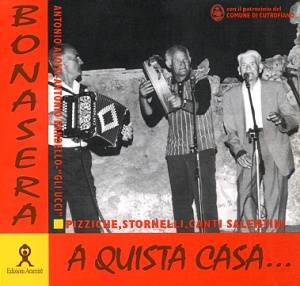| Bonasera a quista casa
"Gli Ucci": pizziche, stornelli, and songs from the Salento region Performers: Antonio
Bandello (voice), Luigi Vergari (voice), Antonio Aloisi
(voice and frame drum), Antonio Melissano (mandolin),
Giuseppe Luceri (guitar), Luigi Stifani (guitar), Roberto
Angelelli (accordion), Giovanni Avantaggiato (diatonic
accordion). Edited by Luigi Chiriatti. Lecce: Edizioni
Aramirč. 1999.
The CD opens with a ritual song for the collection of alms, Santu Lazzaru, whose incipit provides the title of this work. The 16 featured pieces illustrate the variety and wealth of male singing in the village of Cutrufiano, and present the performances of the "Ucci", singers recognized by the community itself as representative of the local musical culture. The group is made up of three singers, accompanied in the "pizziche" and in some of the songs by a frame drum, accordion, mandolin, and guitar. The recordings are of good quality, and document live performances in a way that reflects the level of emotive participation of the singers and the players. The piece Pizzica degli Ucci exemplifies this, as the various singers create a particular tension by means of a rhythmic rubato on the instrumental accompaniment.
The dance arias of the "pizziche" are similar to the epic-narrative and satyrical songs which the "Ucci" share with the vocal repertoire of northern and central Italy, as regards to both text and melodic and vocal style (cf Le tre sorelle, Tuppe tuppe, Cava pių gių Signor Dottore).
In these pieces, the performative technique of the singer resembles one which is found in the Apennine area, with reference also to the use of ornamentations and fiorituras by all the voices. Moreover, Antonio Bandello performs broadside ballads, such as the lament in Italian Quindici anni (Fifteen years) which features the same aria and text throughout Tuscany, Emilia, and Trentino.
This repertoire of polyphonic songs for two or three parts discloses an extraordinary wealth of modes of vocal production. Besides the tight voice of the stornelli and "pizziche", the repertoire presents also a different type of singing featuring the technique of instrumental imitation adopted both by the bass and the "secondo" (‘second’). While the vocal emission of the "primo" (‘first’) is kept relaxed and emphatic - almost as if to imitate tenor singing - to maintain the understanding of the verbal text, the "secondo" and the bass resort to the pronounced nasalization of their vocal emission managing to eliminate the use of the consonants. This strategy enables the attainment of "continuous" sounds favoring melismatic production. Moreover, the repertoire documented in the CD includes stornelli alla carrettiera (carters’ stornelli, cf Aria de li Trainieri), a gangster song (Su'rrivatu a Sanfrangiscu), and an extraordinary local example of a work song, Mara l'acqua, a genre whose genesis is explained by Bandello in an interview quoted in final piece of the CD.
Indeed, the interview in which Antonio Bandello explains the way in which songs are created and performed makes up partly for the only flaw in this work: a lack of contextualizaton of the pieces, presented in terms of their functions and musical style. The booklet includes the translation of the songs’ lyrics - both in Italian by the editor, and in English by Luisa Del Giudice - and two introductory texts by Ignazio Macchiarella and Luisa Del Giudice. Furthermore, Luigi Chiriatti provides precise information on the participants in the different recording sessions, in their capacity as performers, researchers, or collaborators. With this CD Chiriatti offers a first-hand insight into the exceptionally wealthy Apulian ethnomusicological heritage, in the past recovered and transmitted to a broader audience less convincingly by groups of the folk music revival. Placida Staro |
 Bonasera a quista
casa is a fine document about the monodic and
polyphonic vocal culture of the Salento area. Luigi
Chiriatti has been undertaking ethnographic and
ethnomusicological research in his region of origin for
over twenty years, recording the majority of the material
included in this CD in 1979 in the singers’ houses
or during public performances. His profound attention to
the life of a community with which he shares experiences
and culture enabled him to select the repertoire through
an "internal" criterion, unaffected by the
fashionable exoticism or "otherness" which
frequently influence selected recordings in this field.
Bonasera a quista
casa is a fine document about the monodic and
polyphonic vocal culture of the Salento area. Luigi
Chiriatti has been undertaking ethnographic and
ethnomusicological research in his region of origin for
over twenty years, recording the majority of the material
included in this CD in 1979 in the singers’ houses
or during public performances. His profound attention to
the life of a community with which he shares experiences
and culture enabled him to select the repertoire through
an "internal" criterion, unaffected by the
fashionable exoticism or "otherness" which
frequently influence selected recordings in this field.